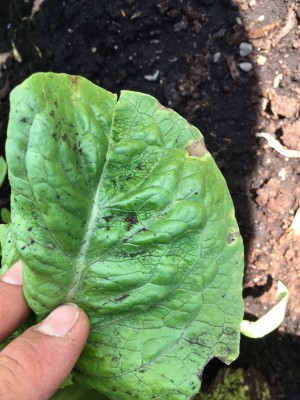Environmental Causes of Tip Burn on Transplants
Ethan Grundberg, Vegetable Specialist
Eastern New York Commercial Horticulture

As discussed in last week's article "Growers are Producing Great Transplants Despite Tough Weather Conditions" by Crystal Stewart, the cool, overcast, and wet spring has posed a number of challenges in propagation greenhouses. As Crystal noted, "high humidity and low light means almost no transpiration by the plants, so soil that is wet stays wet." These environmental conditions can result in a myriad of problems, including fungus gnat infestations, foliar diseases, and the fertility issues discussed by Crystal in the aforementioned article.
Calcium deficiencies in transplants can be another consequence of the short day lengths, overcast skies, cool temperatures, and high humidity that characterized most of the spring. Growers who have battled blossom end rot in tomatoes or tip burn in lettuce likely already understand that these disorders are, technically, caused by calcium deficiencies at the growing point of plants. However, the true culprit is typically not a calcium deficiency in the soil or growing media, but rather erratic watering that prevents the calcium in the soil or potting mix from becoming soluble and being taken up by plants. Getting the calcium into the roots is just the first part of the battle, however.
Calcium is not mobile within plants; instead, it is carried through the plant vascular system along with water that is being sucked through the plant by the process called transpiration. The small openings along leaves, stomata, open up to take in carbon dioxide for photosynthesis and release water in the process. This transpiration is what drives water movement up to the new growth points on plants and, in so doing, carries that calcium to the rapidly growing leaves to reinforce cell walls. What happens to transplants in a cool greenhouse at 95% relative humidity without supplemental light? They transpire exceptionally slowly and don't move calcium to the leaf margins. What happens when such conditions are followed by really warm weather and full sunlight? Plants grow and transpire quickly, but can't immediately supply the calcium demand at growth points which can result initially in small brown spots along the leaf edges that eventually turn papery and can be quickly colonized by secondary foliar pathogens.
Extensive research on tip burn has shown that supplying extra calcium through foliar feeding or fertigation will NOT help plants avoid calcium deficiencies if they are growing under low transpiration conditions. What can growers do to avoid calcium deficiency induced transplant tip burn?
- As Crystal mentioned, "if heading into a period of cold, wet days, minimize watering. And don't be afraid to use gable end vents or ridge vents if it is too wet in the greenhouse!"
- Try to avoid dramatic temperature swings through supplemental heating, venting, and shade cloth; if plants have been grown in the mid-50s, a sudden surge into the 90s can lead to excessively quick growth that results in tip burn.
- Don't panic! Most plants will outgrow early calcium deficiency symptoms once they're in the field under more consistent growing conditions. However, tip burn on quick turn baby lettuces and other leafy greens both reduce the crop's shelf-life post-harvest and, even if minor, can make them unsellable.
- Don't throw water on a grease fire! It's easy to think providing extra calcium will help a plant experiencing a calcium deficiency. However, if the potting mix has sufficient calcium and the deficiency is environmentally-induced, adding extra calcium can actually interfere with the plant uptake of other essential nutrients like magnesium and potassium
This article is from the May 3, 2018 edition of ENYCHP Vegetable News. To read the full newsletter,CLICK HERE.

Upcoming Events
Wine Sensory Evaluation Workshop
April 26, 2024 : Wine Sensory Evaluation Workshop
Staatsburg, NY
In collaboration with Jeremy Schuster, Viticulture Specialist at the ENYCHP, Dr. Anna Katharine Mansfield and Chris Gerling, Enology Extension Specialists with the Cornell Craft Beverage Institute, will be presenting a wine production-focused, interactive workshop on sensory evaluation.
What is my vine trying to tell me?
May 15, 2024 : What is my vine trying to tell me?
Plattsburgh, NY
Are your grapevines showing signs of discoloration or stunted growth? Don't ignore these warning signs! Join us on May 15th at the Cliton County CCE office to learn about the essential nutrients that grapevines require to thrive, identify the symptoms of nutrient deficiencies, and how to fix them. Don't miss out on this opportunity to improve your grapevine cultivation skills! Attendance is free, but registration is required.
How man's best friend can help find Spotted Lanternfly
May 21, 2024
Millbrook, NY
Come and join us at the Dutchess County CCE office on May 21st for a special demonstration by Jennifer Fimbel, the Agriculture and Horticulture Program Leader with Dutchess County CCE. You will get to see her SLF K9 Cole in action as they demonstrate how man's best friend can be used to detect the Spotted Lanternfly. Attendance is free, but registration is required












































